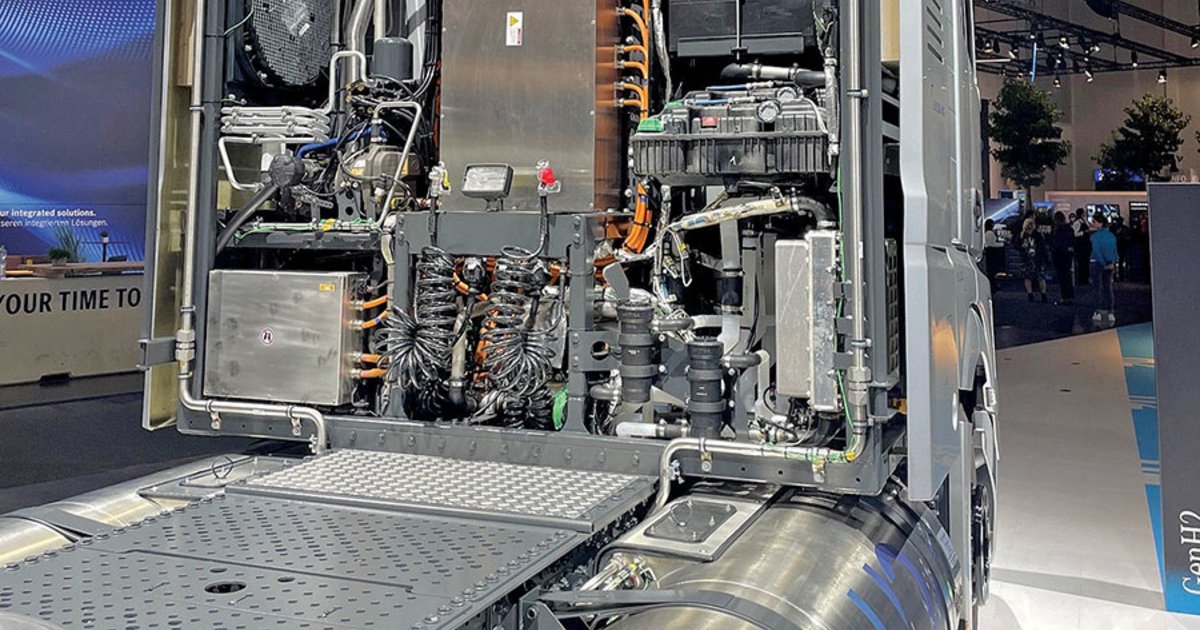
HANOVER, Germany — While the auto industry struggles to convince consumers that hydrogen fuel cell vehicles have a place in daily transportation, truckmakers see huge potential for the technology.
It’s a matter of chemistry, Andreas Gorbach, Daimler Trucks’ technical chief, said at IAA Transportation 2022. No battery chemistry will ever outperform how much energy engineers can store with hydrogen, he said.
“If you take the elements with the biggest difference in electrochemical that gives you the highest energy, the highest voltage and the highest potential energy density cell, you would never come even close to the hydrogen,” Gorbach said.
Even with a significant breakthrough, battery chemistry might only reach a 30th of the energy that hydrogen packs.
“There are not elements that can compete with hydrogen,” Gorbach said.
To be sure, there are still major obstacles to overcome before hydrogen fuel cell trucks can start to replace diesel tractors. There’s almost no fueling infrastructure. The existing hydrogen supply chain couldn’t support trucks by the hundred-thousands.
And hydrogen refining is dirty, defeating the purpose of a zero-tailpipe emissions vehicle. The industry must ramp up producing hydrogen with solar, wind and other renewable energy to fulfill its green promise.
Gorbach worries that the infrastructure bottleneck will leave trucking companies without the best option as governments ban diesel engines.
Even as it develops fuel cell trucks, Daimler continues to push into the battery electric truck market. It unveiled a European model with new battery chemistry at IAA Transportation last week. Daimler CEO Martin Daum told Automotive News that the powertrain and battery chemistry on that truck would make its way into Freightliners plying U.S. roads in several years.
The buzz at IAA centered on battery electric and hydrogen fuel cell models. Daimler, Volvo, BYD, Iveco and nearly every other Class 8 truckmaker placed electric tractors front and center at their IAA booths. They parked the diesel models in secondary positions or outside at the sprawling Frankfurt complex.
Daimler, a standalone truck builder after its December 2021 spinoff from the corporate parent of the Mercedes-Benz car business, touted its hydrogen fuel cell at multiple IAA locations.
Visitors to its primary booth embarked on quiet and smooth rides in Daimler’s GenH2 fuel cell concept big rig. Elsewhere, the German company displayed the latest generation fuel cell stack in development at Cellcentric, a 50-50 joint venture with Volvo Group.
In briefings and interviews, Daum discussed hydrogen technology with a sense of urgency, influenced by the corporation’s timetable for phasing out diesel transport.
“We are in a carbon economy, and carbon heats up the world. … That’s not a world we want to live in,” he said.
Fuel cell powertrains, which use hydrogen to generate electricity to run motors, are a logical substitute for diesel engines to haul goods and materials over the long routes of the U.S., he said.
The weight of the fuel and powertrain is less than that of the heavy batteries electric trucks need to cover similar distances.
Less weight allows motor carriers to haul more freight. And fuel cell trucks refill at about the same speed as combustion engine counterparts.
Volvo also expects fuel cell technology to work better for long ranges and extreme loads.
“We know that it will depend a lot on the infrastructure and the availability of green hydrogen and green electricity,” said Jessica Sandström, Volvo Trucks’ global product management chief.
Volvo is testing fuel cell electric trucks that can run about 600 miles between fueling.
It plans to have customers in Europe testing the trucks in 2025. That will extend to the U.S. and other markets in the following years.
Nikola Corp. is already testing a fuel cell semitrailer in the U.S. and unveiled a version for the European market at IAA Transportation. It plans to launch commercial production of the truck at its factory in Coolidge, Ariz., in the second half of next year and then in Europe the following year, Nikola President Michael Lohscheller told Automotive News.
It also is building fueling infrastructure, starting with one station at the Port of Long Beach and two others in Colton and Ontario near major Southern California distribution hubs.
“I could sell you a truck, but good luck finding hydrogen. … I have to make sure that I can offer you the hydrogen as well. We need to bring these things together,” Lohscheller said.
Others are also testing fuel cell trucks in real-world conditions. Toyota Motor Corp. worked with Kenworth to retrofit 10 diesel-powered Class 8 trucks into fuel cell vehicles for a pilot program in Southern California.
Its success convinced Toyota there is a market selling the zero-emission technology to truck manufacturers. It will build a dual fuel cell module assembly line for heavy-duty commercial at Toyota Motor Manufacturing Kentucky next year.
It plans to keep a couple prototype fuel cell trucks for its parts supply range in the Los Angeles region.
Other companies are exploring urban package delivery and trades.
A partnership between Hyundai Motor Co. and Iveco Group unveiled the eDAILY Fuel Cell Electric Vehicle at IAA. It mates Iveco’s large van to a fuel cell system that first appeared in Hyundai’s Nexo crossover.
The van shows how automakers are repurposing zero-emission tech developed for cars in larger commercial vehicles. The Toyota/Kenworth Class 8 trucks pair fuel cell stacks designed for Toyota’s Mirai sedan.
These advances demonstrate how transportation is leaving a world where internal combustion engines provide an answer for nearly every mobility use, Gorbach said.
Sandström agreed: “We need to be prepared for everything. There will not be a single silver bullet solution for everyone.”